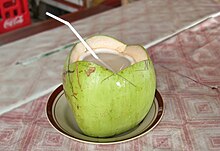**Production and Harvesting of Coconut Water:**
– Fresh coconuts are typically harvested green.
– A hole is bored into the coconut to access the meat.
– Young coconuts may spray liquid and air when opened.
– Fallen coconuts are prone to rot and damage.
– Insects and animals can damage coconuts on the ground.
**Varieties and Nutritional Composition of Coconut Water:**
– Plain coconut water is popular in tropical countries.
– Coconut water is available fresh, canned, or bottled.
– Coconut water provides energy and nutrients.
– It contains carbohydrates, sugars, and fiber.
– Coconut water is low in fat and high in water content.
– It offers small amounts of vitamins and minerals.
**Health Risks and Benefits of Coconut Water Consumption:**
– Excessive consumption can lead to hyperkalemia, potentially causing kidney failure and heart issues.
– Bacterial contamination risk exists in raw coconut water.
– Anecdotal reports link coconut water to senicide in India.
– Rich in electrolytes like potassium and magnesium.
– May help with post-exercise recovery.
– Used as a rehydration fluid in some developing countries.
**Commercialization and Marketing of Coconut Water:**
– Coconut water is marketed as a natural energy drink.
– Promoted as a low-fat, low-calorie sports drink.
– Rich in electrolytes.
– Western countries have seen a rise in coconut water marketing.
– Rapid growth in demand in recent years.
– Increasing presence in supermarkets and health stores.
**Environmental Impact and Global Market Trends of Coconut Water:**
– Sustainable alternative to bottled water.
– Coconut trees require less water than other crops.
– Minimal processing compared to other beverages.
– Supports local economies in tropical regions.
– Rapid growth in demand in recent years.
– Diversification into flavored and functional varieties.
Coconut water (also coconut juice) is the clear liquid inside young coconuts (fruits of the coconut palm). In early development, it serves as a suspension for the endosperm of the coconut during the nuclear phase of development. As growth continues, the endosperm matures into its cellular phase and deposits into the rind of the coconut pulp. The liquid inside young coconuts is sometimes preferred to the liquid of a ripened coconut. Coconut water from young green coconuts is also known specifically as buko juice in Philippine English.



